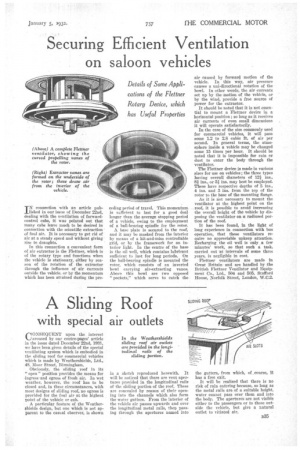Securing Efficient Ventilation on saloon vehicles
Page 49

If you've noticed an error in this article please click here to report it so we can fix it.
connection with an article pub lished in our issue of December 22nd, dealing with the ventilation of forwardcontrol cabs, it was pointed out that many cabs leave much to be desired in connection with the scientific extraction • of foul air. It is necessary to get rid of air at a steady speed and without giving rise to draughts.
in this connection a convenient form of air extractor is the Plettner, which is of the rotary type and functions when the vehicle is stationary, either by reason of the rotation of the extractor through the influence of air currents outside the vehicle, or by the momentum which has been attained during the pre
ceding period of travel.. This momentum. is sufficient to last for a good deed longer than the average stopping period of a vehicle, owing to the employment of a ball-bearing spindle for the rotor.
A base plate is secured . to the roof, and it may be masked from the interior by means of a hit-and-miss controllable grid,' or by the framework for an interior light. In the centre of the base is the oil well, which contains lubricant sufficient to last for long periods. On the ball-bearing spindle is mounted the rotor, which consists of an inverted bowl carrying air-extracting vanes. Above this bowl are two opposed "pockets," which serve to catch the
air caused by forward motion of the vehicle. In this way, air pressure causes a uni-directional rotation of the bowl. In ether words, the air currents set up by the motion of the vehicle, or by the wind, provide a free source of power for the extractor.
It should be noted that it is not essential to mount a PIettner device in a horizontal position; so long as it receives air currents of even small dimensions it Will operate satisfactorily.
In the case of the size commonly used for commercial vehicles, it will pass some 1.2 to 23 cubic ft. of air per second. in general terms, the atmosphere inside a vehicle may be changed some 15 times per hour. It should be noted that it is impossible for ruin or dust to enter the body through the ventilator.
The Flettner device is made in various sizes for use on vehicles; the three types having overall diameters of 121
si ins.' or 5i ins. may best be employed. These have respective depths of 5 ins., 4 ins. and 3 ins, from the top of the rotor to the base of the mounting flange.
As it is dot necessary to mount the ventilator at the highest point on the roof, it is possible to avoid increasing the overall height of the vehicle by disposing the ventilator on a radiused portion of the roof.
It has been found, in the light of long experience in connection with, bus operation, that these ventilators require no appreciable upkeep attention. Recharging the oil well is only a few minutes' work, so that such a task, carried out at intervals of some three years, is negligible in cost.
Plettner ventilators are made in Great Britain • and are handled by :t11 British Flettner Ventilator and Equipment Co., Ltd., 504 and 505, Stafford House, Norfolk Street, London, W.C.2.




























































































